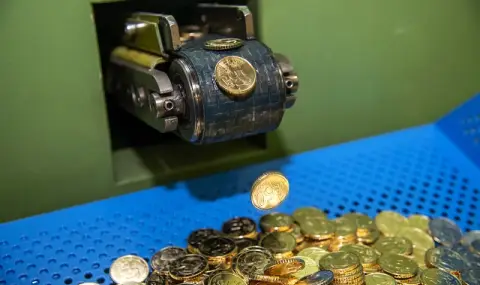An organized crime ring has been busted in Spain, counterfeited two-euro coins, which are probably already all over Europe. How can we recognize counterfeit coins?
News agencies have reported these days that Spanish police have busted an organized crime-counterfeiting ring that allegedly circulated counterfeit two-euro coins across Europe. With the help of Europol, a counterfeit money workshop was successfully busted in Toledo - "the most significant in Europe in the last ten years", according to the police. The gang was able to market almost 500,000 "high quality" counterfeit coins. Ten people were arrested, most likely Chinese citizens.
Spanish police have been working on the case for six years. The investigation was extremely complex and lengthy due to the enormous difficulties in tracking down the counterfeit coins, as well as the fact that the members of the gang kept a strict secret, the DPA agency specifies.
On damages from counterfeit money
Counterfeiting means of payment is known to cause economic damage that affects everyone. Those who accidentally paid with fake banknotes and coins or received them as change also suffered: the fake money is confiscated and they are not entitled to financial compensation.
Although the economic damage in this particular case is not great (half a million counterfeit two-euro coins equals one million euros), the success of the police should not be underestimated. Anyone who has been successfully and undisturbedly distributing fake coins for so long can develop an appetite for more. Above all, however, the psychological effect of the strike against this criminal group is important here - for citizens to rest assured that their money is safe and will retain its value.
Fake banknotes are relatively easy to recognize: they are equipped with a security thread, have embedded holograms, hard-to-copy backgrounds and paper. Coins are something different - for obvious reasons they cannot be protected with holograms or security threads. But even with the "small coins" there are things that a counterfeiter often can't recreate and it's worth looking out for.
How to recognize fake coins?
Bundesbank is responsible for German euro coins. Its experts assure that even laymen can distinguish fake from real coins. Professionals use a standardized European test to check coins that use technical devices.
On its special webpage developed for the coins, the Bundesbank provides valuable information. "On real coins, the relief has precise contours, the image stands out clearly from the rest of the coin's surface. In the case of fakes, the image often looks blurry, somewhat fuzzy, and on a closer look, traces of scratches, spots, lines or illogical depressions can be found on the surface, experts say, it says.
There is one more thing to note. For security reasons, and also to facilitate recognition of the coins by blind people, the edge of the coin is characteristically serrated. "Unlike counterfeit coins, on which the inscription on the edge is often indistinct and lost, on genuine two-euro coins it is clearly recognizable. In addition, the spacing between individual symbols and words on counterfeit coins also often differs from that on genuine coins," the Bundesbank informed.
The magnet trick
The Bundesbank also revealed another method of verification, which, however, assumes the presence of a magnet. Thanks to a special protective material, the one and two euro coins react weakly to a magnetic field in their central part and can be attracted to a magnet. With a slight shake, they fall off the magnet. In contrast, counterfeit 1 and 2 euro coins either do not react to a magnet at all, or on the contrary - stick firmly to it.
However, this detail should also be taken into account: "The outer ring of genuine one and two euro coins, as well as genuine 10, 20 and 50 cent coins, is not magnetic,", experts say. "Genuine one-, two-, and five-cent coins made of copper-plated steel are highly magnetic."
